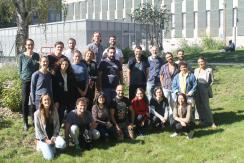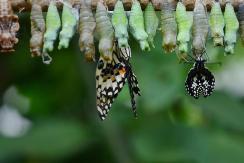COEVOL Multi-Scale Coevolution
Living systems are highly integrated, with a multitude of levels of organization, from molecular and intra-cellular scales to ecosystems. Complex organisms are themselves consortia of macro- and micro-organisms, which work together with their host to build the individual. Yet, each of these organisms can function and evolve in the short term according to its own logic, possibly in conflict with other higher or lower levels, or with other time scales. The once common idea among evolutionists that natural selection results in organisms perfectly adapted to their environment is now severely undermined. Not only because, as the Red Queen explains to Alice, one has to run relentlessly to keep its place in a changing environment, or because past evolutionary history and chance constrain the possibilities of present adaptation, but also because different levels of selection have interests that are generally difficult to reconcile.
Multi-scale coevolution resets classical questions in evolutionary biology
One example, of particular interest is the question of the source of heritable variations. The phenotype of organisms in a population is influenced not only by variations in their nuclear and mitochondrial genomes, the dynamics of which is the object of population genetics, but also more and more patently by the consortium of microbes and genetic elements that constitute its microbiome and virome. The hologenome designates this complex assembly of genetic materials, which obey different rules of transmission and different evolutionary strategies. The ability of symbionts to manipulate host phenotypes or to interfere with each other influences the evolutionary dynamics of all players in ways that are yet poorly understood. In addition, new questions arise, such as the importance of co-adaptation in these systems and their consequences in maintaining cohesive biological systems.
- Symbiosis: a response to and a source of divergent selection
Using a variety of approaches combining experimental evolution, genomic, functional, phenotypic and behavioral data, we aim to test whether symbiosis facilitates diversification and to characterize the underlying microevolutionary processes.
- Ecological networks of horizontal gene transfer
We develop original methods to detect gene transfer and we investigate the factors that influence the routes of gene transfers among microbes but also among insects.
- The interplay between symbiosis, infection and immunity and its evolutionary consequences
We try to understand the intimate interaction of hosts with pathogens, symbionts and transposable elements and how it affects the extended phenotype of the host.
- Transgenerational inheritance and environment changes
We try to decipher the molecular mechanisms that underlie rapid adaptation to environment and to test for transgenerational inheritance of fitness traits.
- Intragenomic conflicts and demography
We are developing models to test whether changes in the demography of the host affect the dynamics of transposable elements.
- The determinism of phenotypic convergence
We study the genomic basis of convergent phenotypic evolution in particular in the case of animals and plants adaptation to increasing temperature and decreasing water.
- Reconciling the tree of life
We develop phylogenetic methods for “reconciling” gene/species or host/symbiont histories and use these methods to explore the bulk of extinct or undescribed species and the history of association of symbiotic microbes with their hosts.
Integrating methods
The methods we use to tackle the questions raised by multi-scale co-evolution extend from theory, modelling and simulation to big data analysis, lab (notably on insects), and to a lesser extent, field activities.
Implication of research, responsibility of researchers and citizen sciences
From our research (some of which have immediate consequences in health, agriculture and ecology) and our concerns about the responsibility of scientists in society, we are committed to promote an “implicative” research. The implicative position means that we try to work on the link between science and society, not only through a one-way communication, applying or explaining our science, but also favoring early discussions on research projects, that may influence our research directions.
Publications
Display of 151 to 180 publications on 710 in total
The transposable element-rich genome of the cereal pest Sitophilus oryzae
BMC Biology . 19 ( 1 ) : 241
Journal article
see the publicationChromosomal scale assembly of parasitic wasp genome reveals symbiotic virus colonization
Communications Biology . 4 ( 1 ) : 1-15
Journal article
see the publicationChapitre 5. Principes, mise en œuvre et perspectives de la technique de l’insecte stérile
Biocontrôle. Éléments pour une protection agroécologique des cultures . 9782759230761 : 75-87
Book chapter
see the publicationIn vivo MRI characterization of the Xlf-/- mouse model of genetic radiosensitivity following low-dose in utero irradiation
European Society for Magnetic Resonance in Medicine and Biology (ESMRMB Congress 2020) .
Conference paper
see the publicationLa tête de « Jupiter capitolin » de Fréjus (Forum Iulii)
Revue archéologique de Narbonnaise . ( 53 ) : 239-266
Journal article
see the publicationGenomic Analysis of European Drosophila melanogaster Populations Reveals Longitudinal Structure, Continent-Wide Selection, and Previously Unknown DNA Viruses
Molecular Biology and Evolution . 37 ( 9 ) : 2661-2678
Journal article
see the publicationSuperparasitism by a parasitoid wasp: The absence of sublethal effects from the neonicotinoid insecticide imidacloprid enlightens the specificity of the cholinergic pathway involved
Ecotoxicology and Environmental Safety . 201 : 110809
Journal article
see the publicationEndosymbiont diversity in natural populations of Tetranychus mites is rapidly lost under laboratory conditions
Heredity . 124 ( 4 ) : 603-617
Journal article
see the publicationTreerecs: an integrated phylogenetic tool, from sequences to reconciliations.
Bioinformatics . 36 ( 18 ) : 4822-4824
Journal article
see the publicationReconciling Gene trees with Species Trees
Phylogenetics in the Genomic Era . : 3.2:1--3.2:23
Book chapter
see the publicationCombining sterile and incompatible insect techniques for the population suppression of Drosophila suzukii
Journal of Pest Science . 93 ( 2 ) : 647 - 661
Journal article
see the publicationAncestral Genome Organization as a Diagnosis Tool for Phylogenomics
Phylogenetics in the Genomic Era . : 2.5:1--2.5:19
Book chapter
see the publicationHomology-Free Detection of Transposable Elements Unveils Their Dynamics in Three Ecologically Distinct Rhodnius Species
Genes . 11 ( 2 ) : 170
Journal article
see the publicationStress & Symbiosis: Heads or Tails?
Frontiers in Ecology and Evolution . : 1-9
Journal article
see the publicationY chromosome makes fruit flies die younger
Peer Community In Evolutionary Biology . : 100105
Other publication
see the publicationDGINN, an automated and highly-flexible pipeline for the detection of genetic innovations on protein-coding genes
Nucleic Acids Research . 48 ( 18 ) : e103-e103
DOI: 10.1093/nar/gkaa680
Journal article
see the publicationA behavior-manipulating virus relative as a source of adaptive genes for Drosophila parasitoids
Molecular Biology and Evolution . 37 ( 10 ) : 2791-2807
Journal article
see the publicationExperimental evolution of virulence and associated traits in a Drosophila melanogaster - Wolbachia symbiosis
Peer Community In Evolutionary Biology . : e9
DOI: 10.24072/pcjournal.9
Journal article
see the publicationInsects and incest: Sib‐mating tolerance in natural populations of a parasitoid wasp
Molecular Ecology . 29 ( 3 ) : 596-609
DOI: 10.1111/mec.15340
Journal article
see the publicationA transposon story : from TE content to TE dynamic invasion of Drosophila genomes using the single-molecule sequencing technology from Oxford Nanopore
Cells . 9 ( 8 ) : 1776
DOI: 10.3390/cells9081776
Journal article
see the publicationViral infection impacts transposable element transcript amounts in Drosophila
Proceedings of the National Academy of Sciences of the United States of America . 117 ( 22 ) : 12249-12257
Journal article
see the publicationSyndrome de Klinefelter, rôle du chromosome Y dans l’espérance de vie humaine ?
36ème Congrès de la Société Française d'Endocrinologie (SFE Marseille 2020) . 81 ( 4 ) : 194
Conference paper
see the publicationGenome Evolution: Mutation Is the Main Driver of Genome Size in Prokaryotes
Current Biology . 30 ( 19 ) : R1083-R1085
Journal article
see the publicationEvolutionary superscaffolding and chromosome anchoring to improve Anopheles genome assemblies
BMC Biology . 18 ( 1 ) : 1-20
Journal article
see the publicationDrosophila suzukii oxidative stress response involves Jheh gene cluster but not transposable elements
Preprint
see the publicationBiological Invasion: The Influence of the Hidden Side of the (Epi)Genome
Functional Ecology . 34 ( 2 ) : 385-400
Journal article
see the publication

